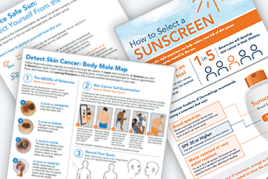How to treat a first-degree, minor burn
How to treat a first-degree, minor burn
Although first-degree burns are not as serious as higher-degree burns, they can hurt quite a bit and can leave a scar if not properly treated. To treat a first-degree burn at home, follow these tips from dermatologists.
First-degree burns are very common and frequently occur after one accidentally touches a hot stove, curling iron, or hair straightener. Sunburn can also be a first-degree burn. Unlike second- or third-degree burns, which are more severe, first-degree burns only involve the top layer of the skin. If you have a first-degree burn, your skin may be red and painful, and you may experience mild swelling.
Most first-degree burns can be treated at home; however, it’s important to know what to do. Although first-degree burns aren’t as serious as higher-degree burns, they can hurt quite a bit and can leave a scar if not properly treated.
To treat a first-degree burn, dermatologists recommend the following tips:
Cool the burn. Immediately immerse the burn in cool tap water or apply cold, wet compresses. Do this for about 10 minutes or until the pain subsides.
Apply petroleum jelly two to three times daily. Do not apply ointments, toothpaste or butter to the burn, as these may cause an infection. Do not apply topical antibiotics.
Cover the burn with a nonstick, sterile bandage. If blisters form, let them heal on their own while keeping the area covered. Do not pop the blisters.
Consider taking over-the-counter pain medication. Acetaminophen or ibuprofen can help relieve the pain and reduce inflammation.
Protect the area from the sun. Once the burn heals, protect the area from the sun by seeking shade, wearing protective clothing or applying a broad-spectrum, water-resistant sunscreen with an SPF of 30 or higher. This will help minimize scarring, as the redness from a burn sometimes persists for weeks, especially in those with darker skin tones.
First-degree burns usually heal on their own without treatment from a doctor. However, if your first-degree burn is very large, if the victim is an infant or elderly person, or if you think your burn is more severe, go to an emergency room immediately.
Have a skin, hair, or nail problem?
No one understands your skin better than a board-certified dermatologist. Partner with the expert for the best care.
 Atopic dermatitis: More FDA-approved treatments
Atopic dermatitis: More FDA-approved treatments
 Biosimilars: 14 FAQs
Biosimilars: 14 FAQs
 How to trim your nails
How to trim your nails
 Relieve uncontrollably itchy skin
Relieve uncontrollably itchy skin
 Fade dark spots
Fade dark spots
 Untreatable razor bumps or acne?
Untreatable razor bumps or acne?
 Tattoo removal
Tattoo removal
 Scar treatment
Scar treatment
 Free materials to help raise skin cancer awareness
Free materials to help raise skin cancer awareness
 Dermatologist-approved lesson plans, activities you can use
Dermatologist-approved lesson plans, activities you can use
 Find a Dermatologist
Find a Dermatologist
 What is a dermatologist?
What is a dermatologist?
